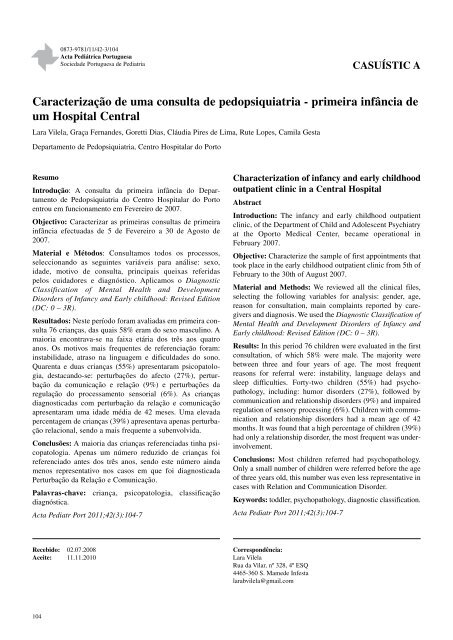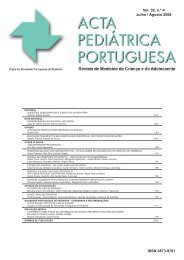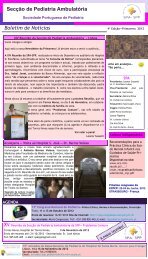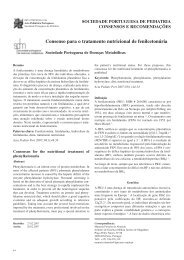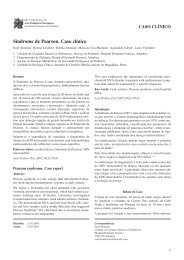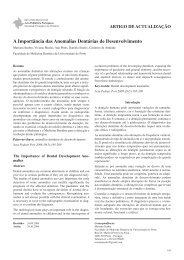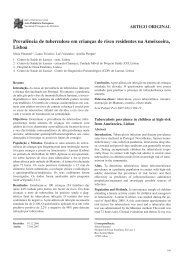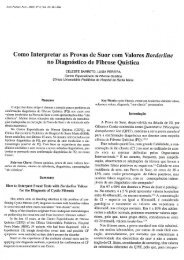Acta Ped Vol 42 N 3 - Sociedade Portuguesa de Pediatria
Acta Ped Vol 42 N 3 - Sociedade Portuguesa de Pediatria
Acta Ped Vol 42 N 3 - Sociedade Portuguesa de Pediatria
You also want an ePaper? Increase the reach of your titles
YUMPU automatically turns print PDFs into web optimized ePapers that Google loves.
0873-9781/11/<strong>42</strong>-3/104<br />
<strong>Acta</strong> <strong>Ped</strong>iátrica <strong>Portuguesa</strong><br />
<strong>Socieda<strong>de</strong></strong> <strong>Portuguesa</strong> <strong>de</strong> <strong>Ped</strong>iatria<br />
CASUÍSTIC A<br />
Caracterização <strong>de</strong> uma consulta <strong>de</strong> pedopsiquiatria - primeira infância <strong>de</strong><br />
um Hospital Central<br />
Lara Vilela, Graça Fernan<strong>de</strong>s, Goretti Dias, Cláudia Pires <strong>de</strong> Lima, Rute Lopes, Camila Gesta<br />
Departamento <strong>de</strong> <strong>Ped</strong>opsiquiatria, Centro Hospitalar do Porto<br />
Resumo<br />
Introdução: A consulta da primeira infância do Departamento<br />
<strong>de</strong> <strong>Ped</strong>opsiquiatria do Centro Hospitalar do Porto<br />
entrou em funcionamento em Fevereiro <strong>de</strong> 2007.<br />
Objectivo: Caracterizar as primeiras consultas <strong>de</strong> primeira<br />
infância efectuadas <strong>de</strong> 5 <strong>de</strong> Fevereiro a 30 <strong>de</strong> Agosto <strong>de</strong><br />
2007.<br />
Material e Métodos: Consultamos todos os processos,<br />
seleccionando as seguintes variáveis para análise: sexo,<br />
ida<strong>de</strong>, motivo <strong>de</strong> consulta, principais queixas referidas<br />
pelos cuidadores e diagnóstico. Aplicamos o Diagnostic<br />
Classification of Mental Health and Development<br />
Disor<strong>de</strong>rs of Infancy and Early childhood: Revised Edition<br />
(DC: 0 – 3R).<br />
Resultados: Neste período foram avaliadas em primeira consulta<br />
76 crianças, das quais 58% eram do sexo masculino. A<br />
maioria encontrava-se na faixa etária dos três aos quatro<br />
anos. Os motivos mais frequentes <strong>de</strong> referenciação foram:<br />
instabilida<strong>de</strong>, atraso na linguagem e dificulda<strong>de</strong>s do sono.<br />
Quarenta e duas crianças (55%) apresentaram psicopatologia,<br />
<strong>de</strong>stacando-se: perturbações do afecto (27%), perturbação<br />
da comunicação e relação (9%) e perturbações da<br />
regulação do processamento sensorial (6%). As crianças<br />
diagnosticadas com perturbação da relação e comunicação<br />
apresentaram uma ida<strong>de</strong> média <strong>de</strong> <strong>42</strong> meses. Uma elevada<br />
percentagem <strong>de</strong> crianças (39%) apresentava apenas perturbação<br />
relacional, sendo a mais frequente a subenvolvida.<br />
Conclusões: A maioria das crianças referenciadas tinha psicopatologia.<br />
Apenas um número reduzido <strong>de</strong> crianças foi<br />
referenciado antes dos três anos, sendo este número ainda<br />
menos representativo nos casos em que foi diagnosticada<br />
Perturbação da Relação e Comunicação.<br />
Palavras-chave: criança, psicopatologia, classificação<br />
diagnóstica.<br />
<strong>Acta</strong> <strong>Ped</strong>iatr Port 2011;<strong>42</strong>(3):104-7<br />
Characterization of infancy and early childhood<br />
outpatient clinic in a Central Hospital<br />
Abstract<br />
Introduction: The infancy and early childhood outpatient<br />
clinic, of the Department of Child and Adolescent Psychiatry<br />
at the Oporto Medical Center, became operational in<br />
February 2007.<br />
Objective: Characterize the sample of first appointments that<br />
took place in the early childhood outpatient clinic from 5th of<br />
February to the 30th of August 2007.<br />
Material and Methods: We reviewed all the clinical files,<br />
selecting the following variables for analysis: gen<strong>de</strong>r, age,<br />
reason for consultation, main complaints reported by caregivers<br />
and diagnosis. We used the Diagnostic Classification of<br />
Mental Health and Development Disor<strong>de</strong>rs of Infancy and<br />
Early childhood: Revised Edition (DC: 0 – 3R).<br />
Results: In this period 76 children were evaluated in the first<br />
consultation, of which 58% were male. The majority were<br />
between three and four years of age. The most frequent<br />
reasons for referral were: instability, language <strong>de</strong>lays and<br />
sleep difficulties. Forty-two children (55%) had psychopathology,<br />
including: humor disor<strong>de</strong>rs (27%), followed by<br />
communication and relationship disor<strong>de</strong>rs (9%) and impaired<br />
regulation of sensory processing (6%). Children with communication<br />
and relationship disor<strong>de</strong>rs had a mean age of <strong>42</strong><br />
months. It was found that a high percentage of children (39%)<br />
had only a relationship disor<strong>de</strong>r, the most frequent was un<strong>de</strong>rinvolvement.<br />
Conclusions: Most children referred had psychopathology.<br />
Only a small number of children were referred before the age<br />
of three years old, this number was even less representative in<br />
cases with Relation and Communication Disor<strong>de</strong>r.<br />
Keywords: toddler, psychopathology, diagnostic classification.<br />
<strong>Acta</strong> <strong>Ped</strong>iatr Port 2011;<strong>42</strong>(3):104-7<br />
Recebido: 02.07.2008<br />
Aceite: 11.11.2010<br />
Correspondência:<br />
Lara Vilela<br />
Rua da Vilar, nº 328, 4º ESQ<br />
4465-360 S. Mame<strong>de</strong> Infesta<br />
larabvilela@gmail.com<br />
104


